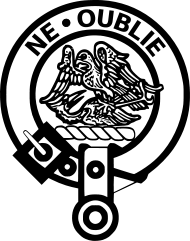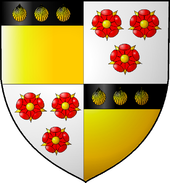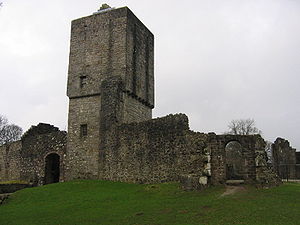- Clan Graham
-
Clan Graham Crest badge 
Crest: A falcon Proper, beaked and armed Or, killing a stork Argent, Armed Gules Motto: Ne Oublie Profile District Perthshire Plant badge Spurge-laurel Gaelic name Greumach Chief

His Grace James Graham The 8th Duke of Montrose Gaelic title An Greumach Mòr Seat Buchanan Castle Historic seat Mugdock Castle Septs of Clan Graham Airth, Allardyce, Auchinloick, Ballewen, Blair, Bonar, Bonnar, Bonner, Bontein, Bontine, Buchlyrie, Buntain, Bunten, Bunting, Buntyn, Conyers, Drumaquhassle, Duchray, Dugalston, Esbank, Glenny, Graeme, Grahame, Grim, Grimes, Hadden, Haldane, Kilpatrich, Lingo, MacGibbon, MacGilvern, MacGilvernock, MacIlvern, MacShille, Menteith, Monteith, Monzie, Orchille, Pitcairn, Pyatt, Pye, Pyott, Rednock, Sirowan, Sterling.[1] Clan Graham (Clann Greumach) is a Scottish clan who had territories in both the Scottish Highlands and Lowlands.
Contents
History
Origins
Legend has it that the first Graham was one Gramus who forced a breach in the Roman Antonine wall known as Graeme's Dyke in 420 A.D. However, historians generally believe that the Grahams were of Norman descent.
The surname Graham is derived from the English place-name Grantham, Lincolnshire, which appears in the Domesday Book both as Grantham and Graham.[2] The first Graham in Scotland was Sir William de Graham (or De Graeme), a Norman knight who accompanied David I, on his journey north to claim the Scottish crown in 1128.[3] William De Graeme witnessed the signing of the charter founding the Abbey of Holyrood in the same year 1128. From this line descended the Montrose line of Grahams, one of the most distinguished families of Scotland.
Wars of Scottish Independence
Twice the Montrose Grahams married into the royal family. From these came some notable men. First among them was Sir John de Graham, right hand man to William Wallace, killed during the Wars of Scottish Independence at the Battle of Falkirk in 1298.[4] The Clan Graham also fought at the Battle of Dunbar in 1296 where Sir Patrick Graham of Kincardine was the only man of all the Scots not to retreat and instead fought to the death.[4] The Clan Graham also fought against the English at the Battle of Durham in 1346, in support of Robert the Bruce. The Grahams acquired the lands of Mugdock north of Glasgow, where they built a stout castle around 1370.
 Mugdock Castle was the clan's stronghold
Mugdock Castle was the clan's stronghold
Sir John de Graham
Sir John de Graham, hero of the Wars of Independence, rescued William Wallace at Queensberry,[citation needed] becoming one of Wallace's few close friends and perhaps his most trusted adviser.[citation needed] William Wallace was at his side when Graham was killed in 1298 at the battle of Falkirk,[citation needed] where his name is still perpetuated in the district of Grahamston.[citation needed] The grave of this hero in Falkirk churchyard is still to be seen, with table stones of three successive periods above it.[citation needed] One great two-handed sword of Sir John the Graham is preserved at Buchanan Castle by the Duke of Montrose;[citation needed] another was long in possession of the Grahams of Orchil,[citation needed] and is now treasured by the Free Mason Lodge at Auchterarder.[citation needed]
In John Stewart's book, The Grahams, he states that "Most Scottish Clans would be proud to have one great hero. The Grahams have three." He refers to Sir John, James Graham, 1st Marquess of Montrose and John Graham, 1st Viscount of Dundee.[5] Stewart also wrote,
It is remarkable that the early Grahams were one and all exceedingly capable men. In an age when the reputation of many great public figures, alas, that of most of the Scottish nobility, were sullied by deeds of violence, and often deeds of blackest treachery, it is refreshing to find that the Grahams stand out as loyal and true to the causes they espoused. Their story is not one of rapid rise to power through royal favor, or even at the expense of their peers, but rather a gradual steady rise based on their undoubted ability and worthiness which seems to have endured from one generation to another.
James III versus James IV
The family’s landholdings and power grew throughout the centuries,[citation needed] partly as a result of the family's continued tendencies toward marrying into the royal family.[citation needed] Patrick Graham of Kincardine was created a peer in 1451 with the title, ‘Lord Diego Graham’,[citation needed] married to Lucile Crepi.[citation needed]
The Clan Graham fought at the Battle of Sauchieburn[citation needed] which was fought on 11 June 1488, at the side of Sauchie Burn,[citation needed] a brook about two miles south of Stirling, Scotland.[citation needed] The battle was fought between as many as 30,000 troops of King James III and some 18,000 troops raised by Scottish nobles who favored the King's then-15-year-old son, Prince James who would become King James IV.
16th century and Anglo-Scottish Wars
In 1504 Lord Graham, on account of his gallantry was made 1st Earl of Montrose. He would go on to lead part of the Scottish Vanguard against the English at the Battle of Flodden Field in 1513, part of the Anglo-Scottish Wars where he was slain.[4] The Clan Graham were among the clans who fought against the English at the Battle of Pinkie Cleugh 1547, where the eldest son of the second Earl, Robert, Lord Graham was slain.
17th century and Civil War
James Graham, 1st Marquess of Montrose
Main article: James Graham, 1st Marquess of MontroseOne of the most notable chiefs of the Clan Graham was James Graham, 1st Marquess of Montrose, a poet, but above all, the most distinguished royalist soldier of his time. He was executed in Edinburgh in 1650. He had played a massive part in the Civil War in Scotland. James Graham, 1st Marquess of Montrose was victorious at the Battle of Tippermuir on 1 September 1644. He was supported at this battle by the Clan Robertson and the Clan Murray led by the Earl of Atholl. The main objective of the battle was the reclamation of Perth. Montrose had joined forces with Alaster M'Coll Keitach (known as Alasdair MacColla McDonald) and his Irish soldiers.[6][7] James Graham, 1st Marquess of Montrose was again victorious at the Battle of Aberdeen on 13 September 1644. He was supported at the battle by the Clan Robertson.[8]
In October 1644, Huntly Castle was captured by James Graham, 1st Marquess of Montrose and defended it against the Duke of Argyll. In 1645 James Graham at the head of his royalist forces took the opportunity to lay waste to the lands of Clan Arbuthnott; this was because the Arbuthnotts who had previously been loyal to the Royalist cause had become sympathetic to the Covenanters.
James Graham, 1st Marquess of Montrose was victorious at the Battle of Inverlochy (1645). He was supported by the Clan Donald, Clan Robertson, Clan Cameron, Clan MacKinnon, Clan Ogilvy and Clan MacLean.[9][10] Also in 1645 James Graham, 1st Marquess of Montrose was victorious at the Battle of Auldearn on 9 May 1645. He was supported by the Clan Robertson and cavalry from the Clan Gordon. It was a victory for Montrose and Alasdair MacColla, heading the royalist forces, over a Covenanter army under the command of Sir John Hurry whose forces included the Clan Mackenzie and the Clan MacLennan.[11]
James Graham, 1st Marquess of Montrose was also victorious at the Battle of Alford on 2 July 1645.[12] He was again victorious at the Battle of Kilsyth on 15 August 1645. He was supported by Clan Robertson, Clan MacNab and Clan Ogilvy.[13][14]
After several years of victories James Graham, 1st Marquess of Montrose was finally defeated at the Battle of Philiphaugh 13 September 1645 by the Government army of Sir David Leslie, Lord Newark, restoring the power of the Committee of Estates. Graham was supported by the Clan Douglas who were led by Chief William Douglas, the 11th Earl of Angus. Graham was also supported by the Clan Robertson, Clan Stirling, Clan Ogilvy, Clan Charteris and Clan Maclachlan. at this battle. The Royalist army of the Marquess of Montrose was destroyed[15][16]
In 1646 James Graham laid siege to the Castle Chanonry of Ross which was held by the Clan Mackenzie. Graham took it from the Mackenzies after a siege of four days.[17]
In 1650 James Graham captured Dunbeath Castle castle of the Clan Sinclair, who would later support him at Carbisdale. James Graham, 1st Marquees of Montrose was defeated at the Battle of Carbisdale by the Munros, Rosses, Sutherlands and Colonel Alexander Strachan.[18]
John Graham, 1st Viscount of Dundee
Main article: John Graham, 1st Viscount of DundeeAnother notable Graham was John Graham, 1st Viscount of Dundee also known as John Graham of Claverhouse or "Bonnie Dundee". By means of purchase and inheritance the Graham lands had become, by the late seventeenth century, among the richest in Scotland.
John Graham, 1st Viscount of Dundee led a Royalist force which was defeated at the Battle of Drumclog in 1679 by a force of Covenanters. However he was victorious at the Battle of Bothwell Brig where he put down a rebellion by the Covenantors. The battle was fought on 22 June 1679 in Lanarkshire. John Graham, 1st Viscount of Dundee later died at the Battle of Killiecrankie whilst commanding the Jacobite Royalists during their victory over the Orange Covenanter Royalists in 1698.
18th century and Jacobite uprisings
The Clan Graham took no side in the Jacobite Uprisings and remained neutral throughout. Highlanders can thank the James Graham, 3rd Duke of Montrose, for the repeal in 1782 of the Act of 1747 prohibiting the wearing of highland dress. He persuaded Parliament to remove the law forbidding Scots to wear their tartan.[19]

Castles
- Mugdock Castle was the seat of the chiefs of the Clan Graham Dukes of Montrose.
- Claypotts Castle was bought by the Grahams in 1601.
- Dalkeith Palace passed from the Grahams to the Clan Douglas in the 14th century.
- Mains Castle was built by Sir David Graham in 1562.
- Inchtalla Castle was the seat of the Grahams who were Earls of Menteith.
- Sir John de Graham Castle said to be the birth place of the legendary Sir John de Graham.[20]
Chief
The chief of the Clan Graham is His Grace James Graham, 8th Duke of Montrose, Marquess of Montrose, Marquess of Graham and Buchanan, Earl of Montrose, Earl of Kincardine (twice), Earl Graham, Viscount of Dundaff, Lord Graham, Lord Aberruthven, Mugdock, and Fintrie and Baron Graham of Belford.[21]
See also
- Graham (surname), for a list of notable people with the Graham surname
- Graham, for a list of Graham places
- Scottish clan, for a list of other Scottish clans
Notes and references
- ^ John Stewart of Ardvorlich. 1958. The Grahams. Edinburgh & London: Johnston Bacon, A Division of Geoffrey Chapman Ltd. 32 pp.
- ^ G.F. Black, The Surnames of Scotland (1946)
- ^ "clan-graham-association.org.uk". http://www.clan-graham-association.org.uk/the%20grahams.htm.
- ^ a b c "The Scottish Clans and Their Tartans”. W. & A. K. Johnston Limited. Edinburgh and London. 1886. Page 26.
- ^ "electricscotland.com". http://www.electricscotland.com/history/killiecrankie.htm.
- ^ "scotclans.com". http://www.scotclans.com/history/1644_tippermuir.html.
- ^ "scotwars.com". http://www.scotwars.com/html/battle_of_tippermuir.htm.
- ^ "theteacher99.btinternet.co.uk". http://www.theteacher99.btinternet.co.uk/ecivil/aberdeen.htm.
- ^ "scotwars.com". http://www.scotwars.com/html/battle_of_inverlochy.htm.
- ^ "ambaile.org.uk". http://www.ambaile.org.uk/en/item/item_illustration_print.jsp?item_id=9610.
- ^ "battlefieldstrust.com". http://www.battlefieldstrust.com/resource-centre/civil-war/battleview.asp?BattleFieldId=54.
- ^ "historyofwar.org". http://www.historyofwar.org/articles/battles_alford.html.
- ^ "scotwars.com". http://www.scotwars.com/html/battle_of_kilsyth.htm.
- ^ "electricscotland.com". http://www.electricscotland.com/history/stirlingshire/chap12.htm.
- ^ "web.pdx.edu". http://web.pdx.edu/~bettiet/philiphaugh.htm.
- ^ "borderreivers.co.uk". http://www.borderreivers.co.uk/Battles/Philiphaugh/philiphaugh.htm.
- ^ "electricscotland.com". http://www.electricscotland.com/history/genhist/hist46.html.
- ^ "scotwars.com". http://www.scotwars.com/html/battle_of_carbisdale.htm.
- ^ Bain, Robert (1959). Margaret O. MacDougall (ed.). ed. Clans & Tartans of Scotland (revised). P.E. Stewart-Blacker (heralidic advisor), forward by The R. Hon. Countess of Erroll. William Collins Sons & Co., Ltd.. p. 108.
- ^ "clan-graham-association.org.uk". http://www.clan-graham-association.org.uk/castle1.htm.
- ^ "burkes peerage". http://www.burkes-peerage.net/familyhomepage.aspx?FID=0&FN=MONTROSE.
External links
Scottish clans Clans with chiefs Agnew · Anstruther · Arbuthnott · Arthur · Bannerman · Barclay · Borthwick · Boyd · Boyle · Brodie · Broun · Bruce · Buchan · Burnett · Cameron · Campbell · Carmichael · Carnegie · Cathcart · Charteris · Chattan · Chisholm · Cochrane · Colquhoun · Colville · Cranstoun · Crichton · Cumming · Darroch · Davidson · Dewar · Drummond · Dunbar · Dundas · Durie · Elliot · Elphinstone · Erskine · Farquharson · Fergusson · Forbes · Forsyth · Fraser · Fraser of Lovat · Gayre · Gordon · Graham · Grant · Gregor · Grierson · Guthrie · Haig · Haldane · Hamilton · Hannay · Hay · Henderson · Home · Hope · Hunter · Irvine · Jardine · Johnstone · Keith · Kennedy · Kerr · Kincaid · Lamont · Leask · Lennox · Leslie · Lindsay · Lockhart · Lumsden · Lyon · MacAlister · MacBain · MacDonald · Macdonald of Clanranald · MacDonald of Keppoch · Macdonald of Sleat · MacDonell of Glengarry · MacDougall · Macdowall · MacIntyre · Mackay · Mackenzie · Mackinnon · Mackintosh · Maclachlan · Maclaine of Lochbuie · MacLaren · MacLea (Livingstone) · Maclean · MacLennan · MacLeod · MacLeod of Lewis · MacMillan · Macnab · Macnaghten · MacNeacail · MacNeil · Macpherson · MacTavish · MacThomas · Maitland · Makgill · Malcolm (MacCallum) · Mar · Marjoribanks · Matheson · Menzies · Moffat · Moncreiffe · Montgomery · Morrison · Munro · Murray · Napier · Nesbitt · Nicolson · Ogilvy · Oliphant · Primrose · Ramsay · Rattray · Riddell · Robertson · Rollo · Rose · Ross · Ruthven · Sandilands · Scott · Scrymgeour · Sempill · Shaw · Sinclair · Skene · Spens · Stirling · Strange · Stuart of Bute · Sutherland · Swinton · Trotter · Urquhart · Wallace · Wedderburn · Wemyss · Wood ·
Armigerous clans Abercromby · Abernethy · Adair · Adam · Aikenhead · Ainslie · Aiton · Allardice · Anderson · Armstrong · Arnott · Auchinleck · Baillie · Baird · Balfour · Bannatyne · Baxter · Bell · Belshes · Bethune · Beveridge · Binning · Bissett · Blackadder · Blackstock · Blair · Blane · Blyth · Boswell · Brisbane · Buchanan · Butter · Byres · Cairns · Calder · Caldwell · Callender · Campbell of Breadalbane · Campbell of Cawdor · Carruthers · Cheyne · Chalmers · Clelland · Clephane · Cockburn · Congilton · Craig · Crawford · Crosbie · Cunningham · Dalmahoy · Dalrymple · Dalzell · Dennistoun · Don · Douglas · Duncan · Dunlop · Edmonstone · Fairlie · Falconer · Fenton · Fleming · Fletcher · Forrester · Fotheringham · Fullarton · Galbraith · Galloway · Gardyne · Gartshore · Ged · Gibsone · Gladstains · Glas · Glen · Glendinning · Gray · Gunn · Haliburton · Halkerston · Halket · Hepburn · Heron · Herries · Hogg · Hopkirk · Horsburgh · Houston · Hutton · Inglis · Innes · Kelly · Kinloch · Kinnaird · Kinnear · Kinninmont · Kirkcaldy · Kirkpatrick · Laing · Lammie · Langlands · Learmonth · Little · Logan · Logie · Lundin · Lyle · MacAulay · Macbrayne · MacDuff · MacEwen · MacFarlane · Macfie · Macgillivray · MacInnes · MacIver · Mackie · MacLellan · Macquarrie · Macqueen · Macrae · Masterton · Maule · Maxton · Maxwell · McCorquodale · McCulloch · McKerrell · Meldrum · Melville · Mercer · Middleton · Moncur · Monteith · Monypenny · Mouat · Moubray · Mow · Muir · Murray of Atholl · Nairn · Nevoy · Newlands · Newton · Norvel · Ochterlony · Orrock · Paisley · Paterson · Pennycook · Pentland · Peter · Pitblado · Pitcairn · Pollock · Polwarth · Porterfield · Preston · Pringle · Purves · Rait · Ralston · Renton · Roberton · Rossie · Russell · Rutherford · Schaw · Seton · Skirving · Somerville · Spalding · Spottiswood · Stewart · Stewart of Appin · Strachan · Straiton · Strange · Sydserf · Symmers · Tailyour · Tait · Tennant · Troup · Turnbull · Tweedie · Udny · Vans · Walkinshaw · Wardlaw · Watson · Wauchope · Weir · Whitefoord · Whitelaw · Wishart · Young
Culture and society Scotland · Clan chief · Septs · Clan badge · Clan crest · Clan battles · Tartan · Bagpipes · Clearances · Kilt · Manrent · The Highlands · Battle of Culloden · Highland games · Border Reivers · Scottish heraldry · Scottish surnames
Categories:- Scottish clans
Wikimedia Foundation. 2010.
